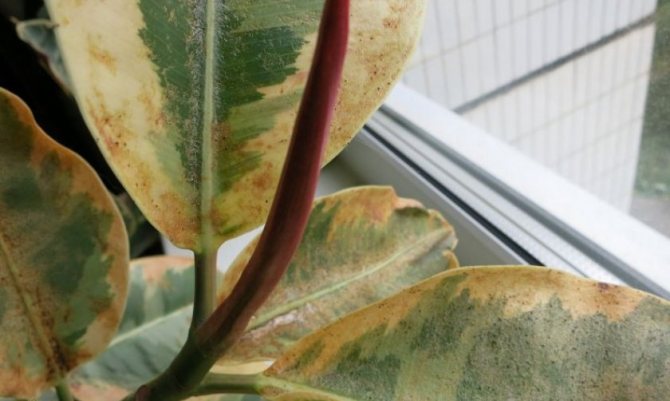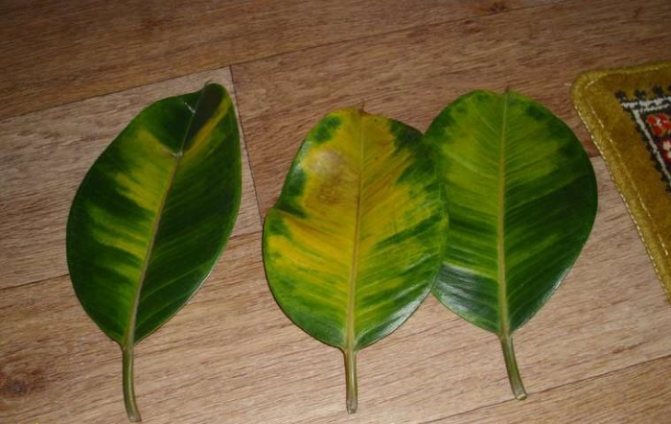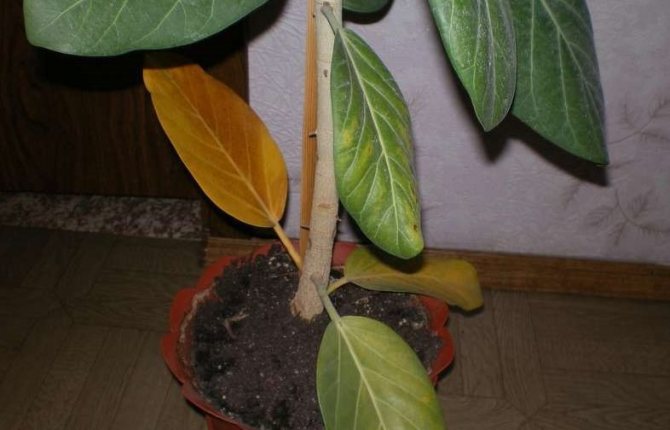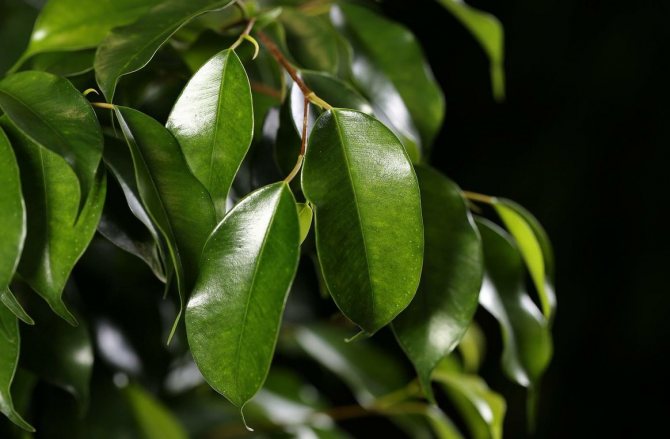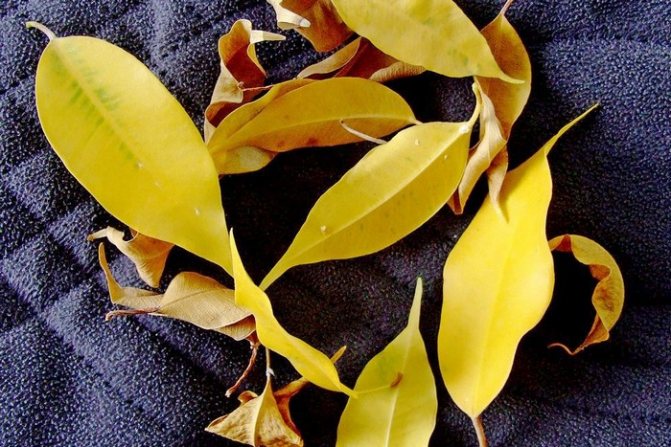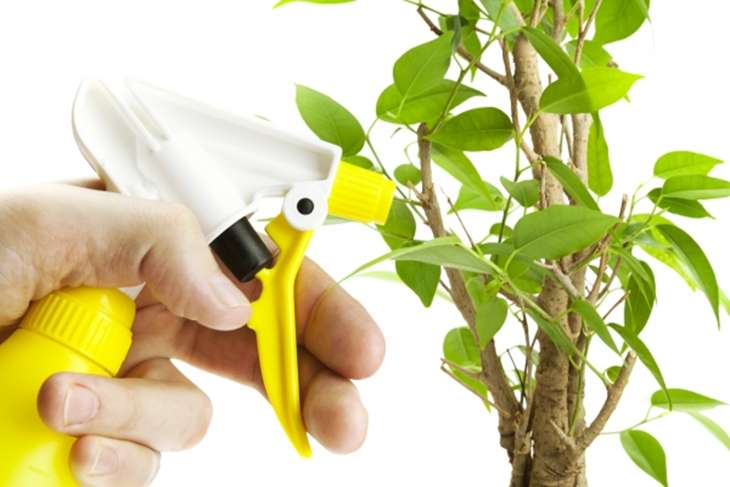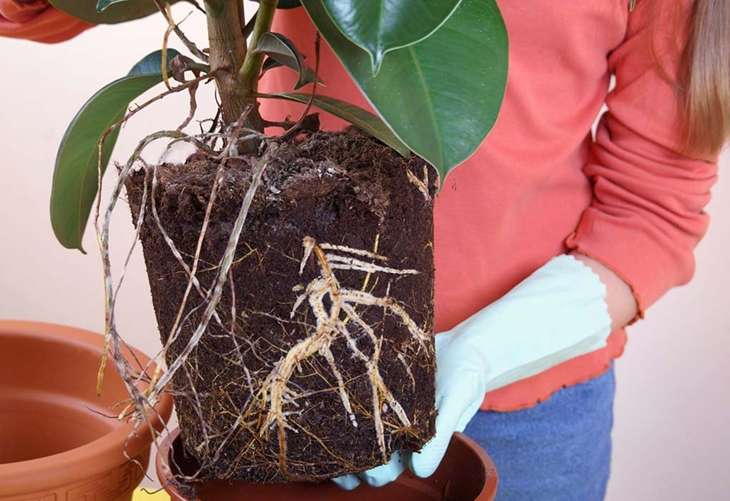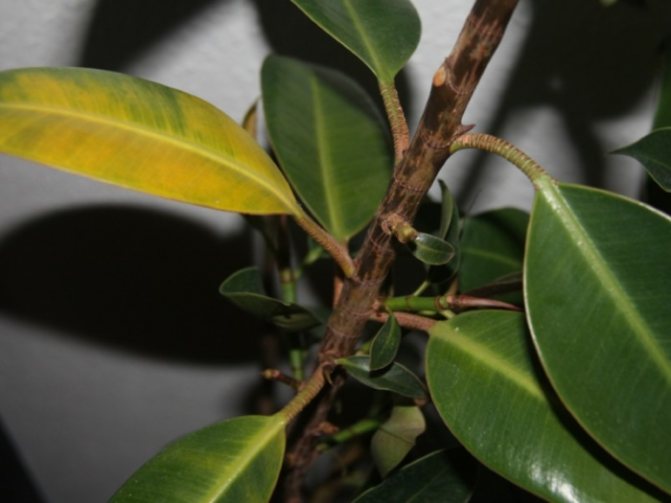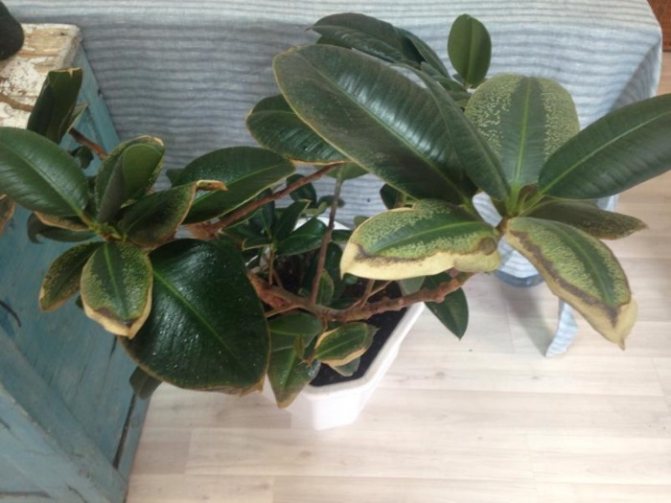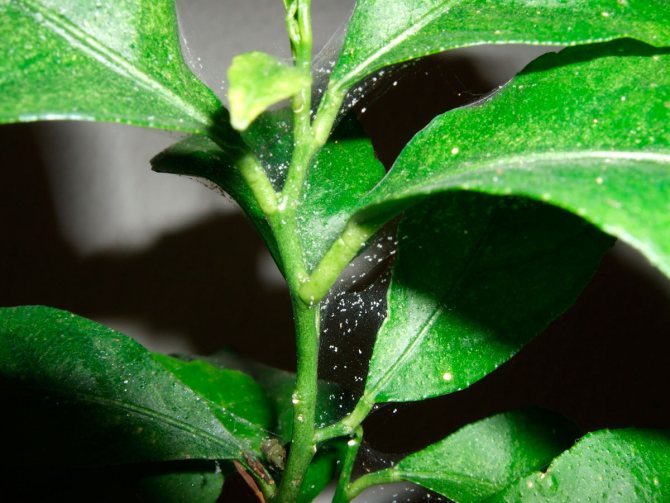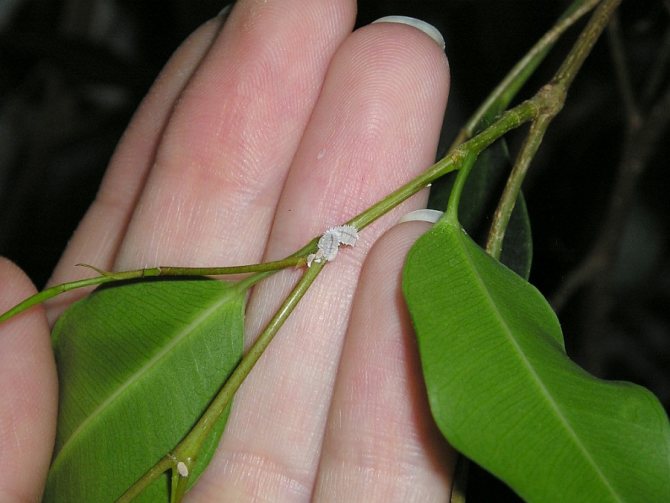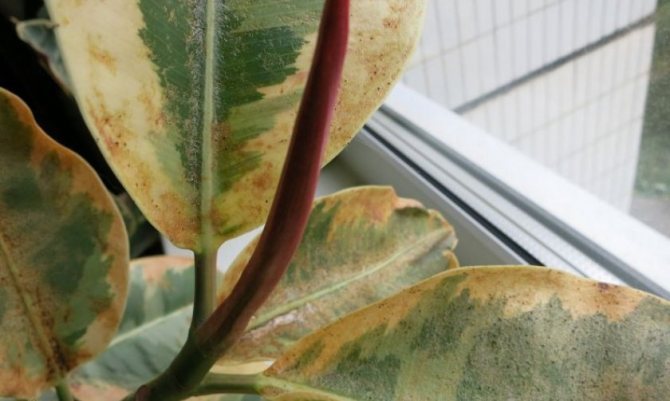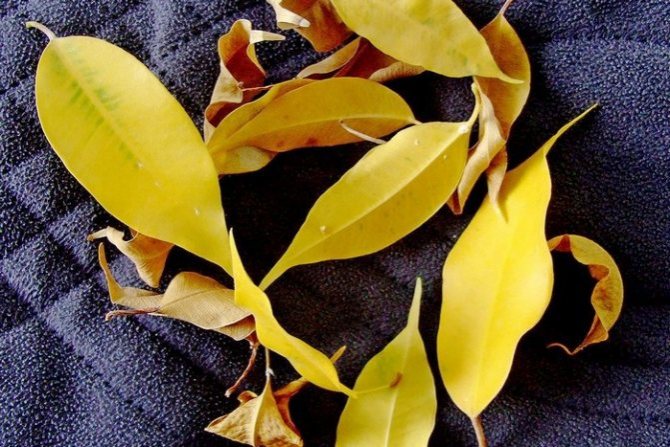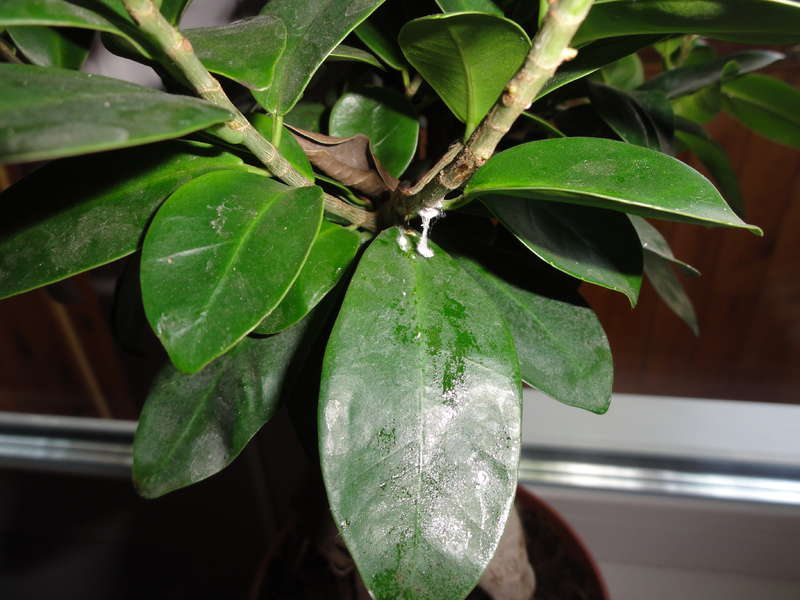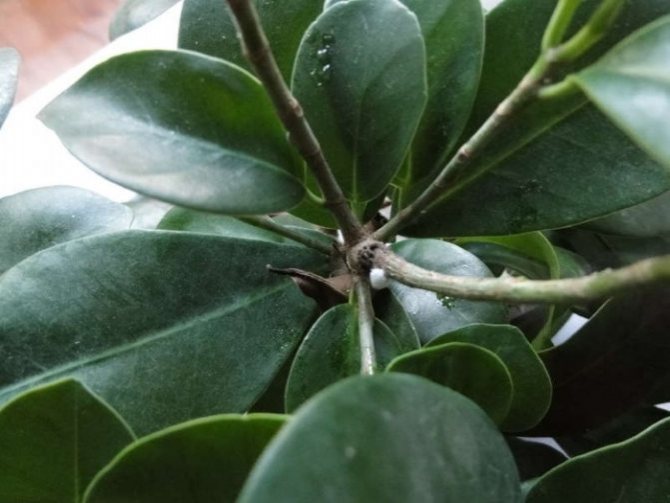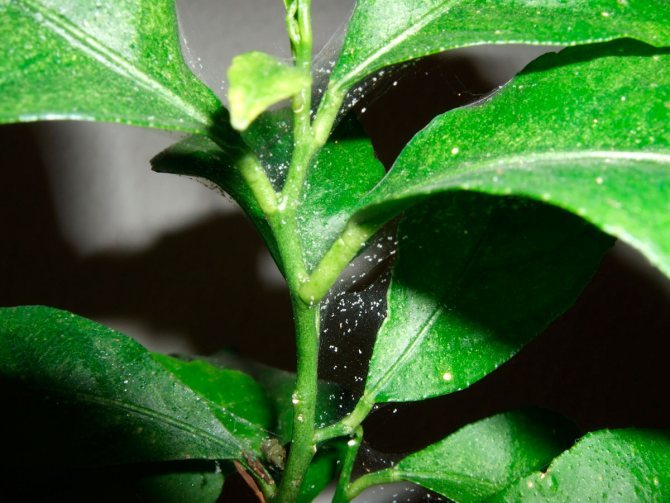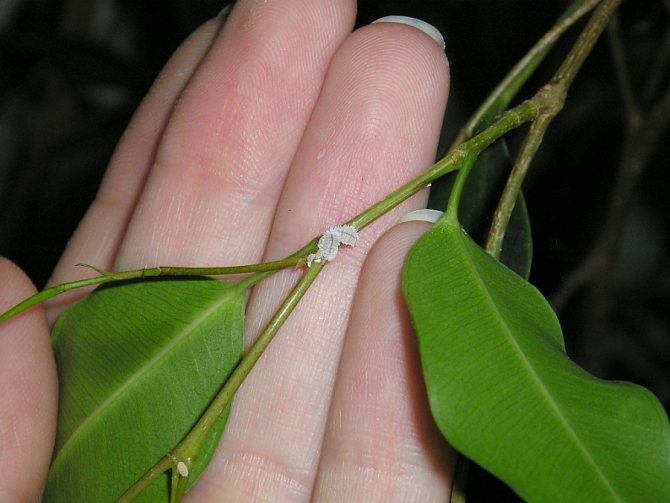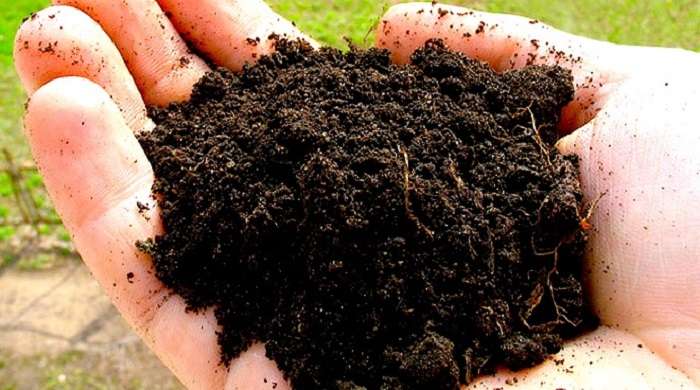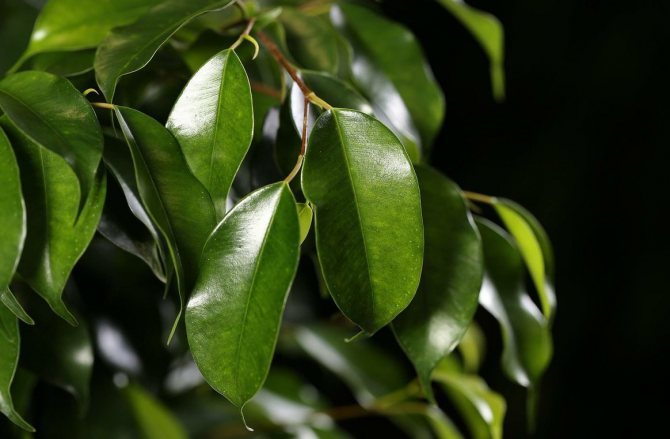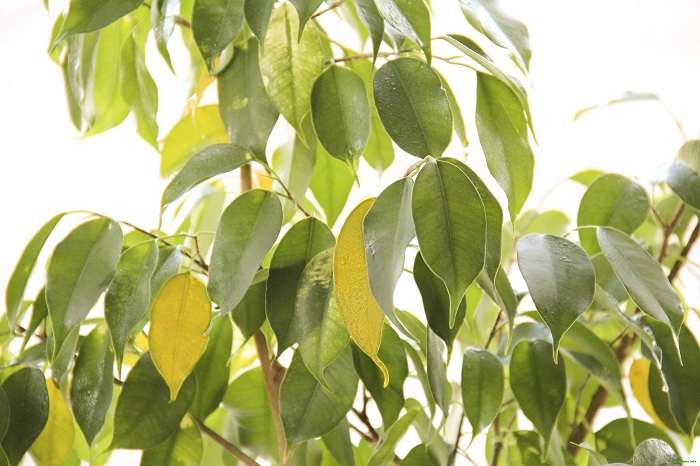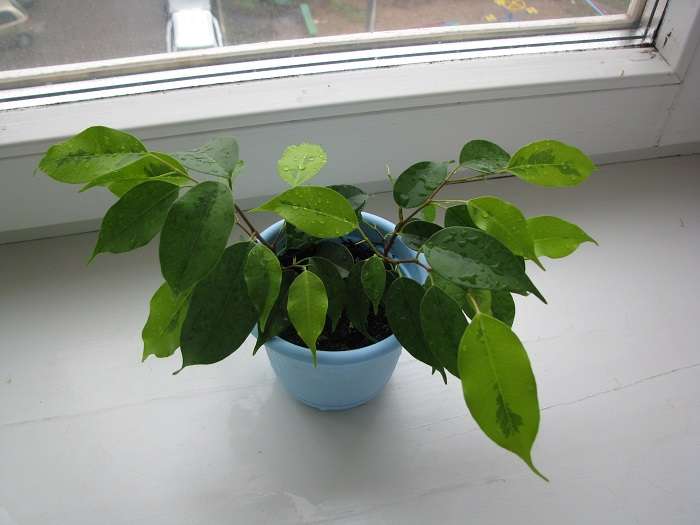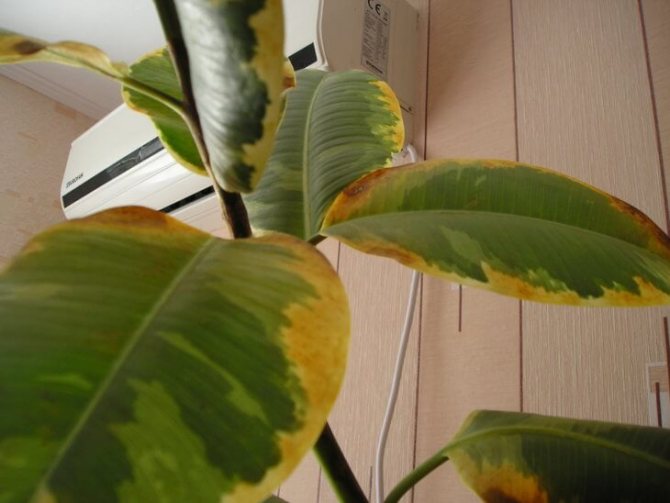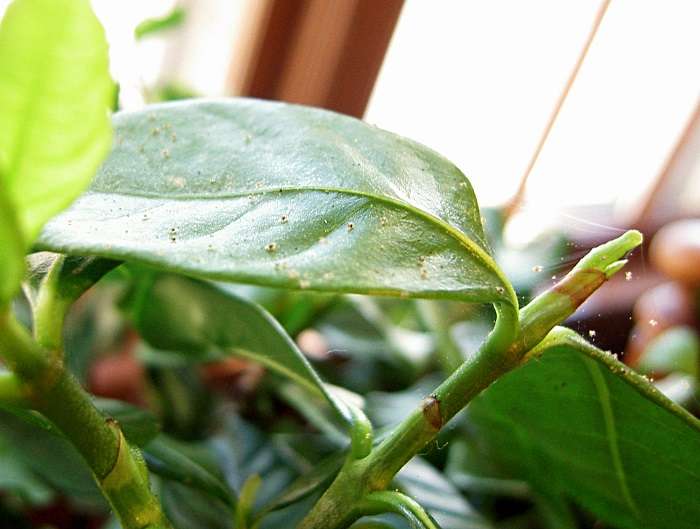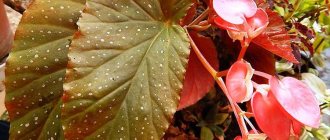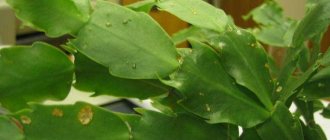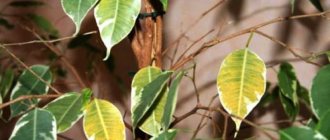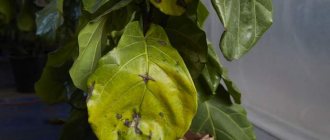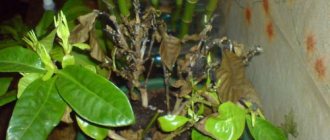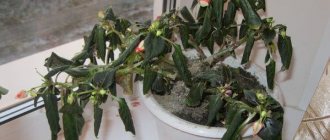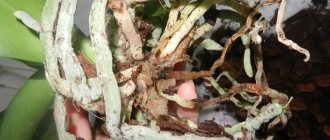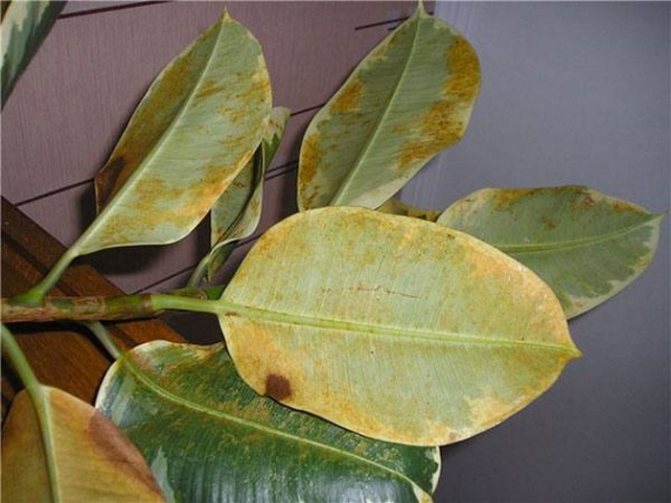
Indoor plants, as well as terrestrial slopes, are prone to various diseases. The home flower changes, the foliage and stems become stained, turn yellow, dry and fall off. Why molds in ficus turn yellow, there can be many reasons. Before proceeding with the elimination of the disease, it is worth considering in more detail each of them.
Why do ficus leaves turn yellow and fall off? The main causes of yellowing of leaves
If you begin to notice that more and more sluggish and yellowing leaves appear on your favorite ficus every day, the reason for this condition lies, most likely, in improper care or plant disease. Further in the article, we will tell you in more detail what exactly the leaves of these plants can wither and turn yellow from.
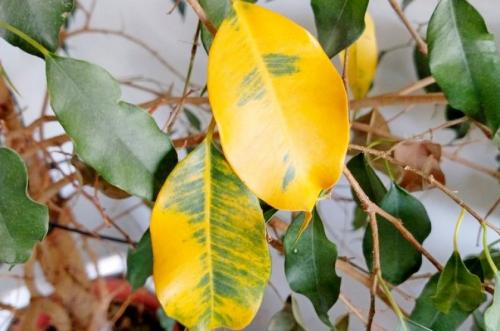

Incorrect transplant
Transplanting into a new pot with new soil is stressful for every indoor plant, and ficus is no exception. However, in any case, for the normal development of a plant, it cannot do without a transplant, so carefully choose a soil mixture for a ficus - high-quality soil will help it survive the acclimatization period.
Cold
By their nature, ficuses are thermophilic plants. To provide them with comfortable conditions for growth and further development, find a bright place in the room without drafts. But direct sunlight should also be avoided - they can cause burns on the leaves. Even during the winter months, it is important to keep the room temperature at least +18 ° C. However, in pursuit of heat, do not place the pot next to heating devices - sudden temperature changes and excessive dryness of the air can destroy the ficus much faster than cold air.
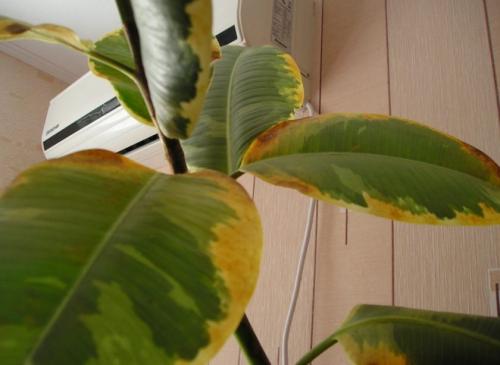

Lack of nutrients
The constant development of the root system of any plant in a closed pot over time leads to depletion of the soil and weakening of the flower due to a lack of nutrients. If you noticed the deterioration in the appearance of the ficus, then do not hesitate to apply fertilizers. The main thing to remember is that you do not combine plant feeding with transplanting them to a new place.
Important! To determine if the ficus needs watering, pierce the soil with a wooden stick. If it is dry to a depth of 2 fingers, then the water will not interfere with the flower.
Wrong watering regime
Irregular watering is the most common cause of sudden yellowing of leaves. Experienced gardeners recommend watering the flowers only after the soil is completely dry. Just once a flower is poured, you can provoke the process of rotting of its root system.
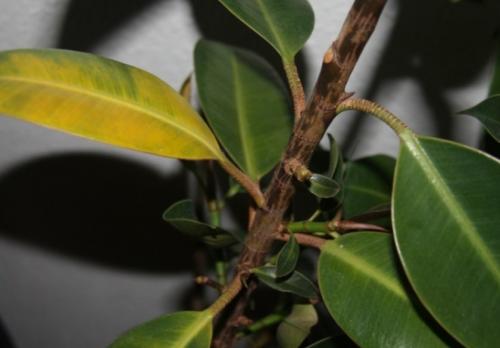

Pests and diseases
If you are sure that the optimal ratio of temperature and humidity is observed in the room where the ficus lives, and that watering and fertilizing with fertilizers is regular and scheduled by the hour, then most likely the plant suffers from insects. Carefully inspect the ground near the rhizome and every leaf that can serve as a treat for pests. Sometimes the yellow color of the foliage can indicate that the flower is affected by a fungus. Treatment with special fungicides for indoor plants will help to improve his health.
Important! Having found traces of insects or fungal infections, it is important to immediately isolate the diseased ficus from neighboring plants and start treating it with the necessary preparations. Otherwise, other flowerpots can easily become infected.
Pests
If you keep the plant correctly, the answer to the question of why the ficus loses leaves is the reason for the presence of pests.
Examine the flower carefully. If there are holes, plaque, spots, grooves on it, you may have insects. When a pest is identified, the ficus should be resettled for a while, and then treated with special insecticides according to the recipe.
The correct location, proper fertilization and location in the room will have a beneficial effect on the condition of the plant and you no longer have to face the problem of why the crown of the ficus turns yellow and falls off.
How to properly water ficus
General rules for watering ficuses
Proper watering is almost the basic rule of care and the key to a beautiful and stable growth, development and flowering of any indoor plant. Ficus is no exception. He is not demanding, but still separate rules must be adhered to.
First of all, the water should be settled and by no means cold, preferably at room temperature. You can pick up a container of water that will stand on the windowsill (or any other place where the flowerpot lives). In this way? the fulfillment of as many as three rules will be ensured: firstly, the water will settle, secondly, it will have an optimal temperature and thirdly, a bottle of water standing by the plant will not let you forget about watering.
In the question of how often the ficus should be watered, it is necessary to be guided solely by monitoring the condition of the soil; it is difficult to establish a clear schedule. If it is a small plant, then at a level of drying for 1-2 phalanges of the fingers, you can water it, if the ficus is large, when it dries out by 6-7 centimeters.
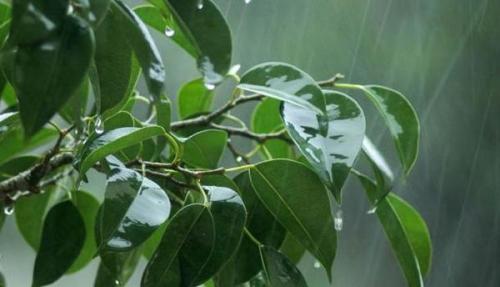

How to water Benjamin's ficus
More specifically, we will determine how to water Benjamin's ficus in winter and during the warm season, so that it can grow quickly and not experience any inconvenience.
When, when checking the condition of the soil, there is a noticeable drying out of its top layer, watering is needed. The amount of water should be moderate, if Benjamina feels excess moisture, then she begins to shed the leaves. For the leaves, regular spraying will be useful, but at low air temperatures or with the likelihood of a draft, it is categorically contraindicated, as well as in the presence of direct sunlight.
In the hot season, it is necessary to provide the plant with more intensive watering than in autumn and winter, the soil dries out faster and the need for moisture increases.
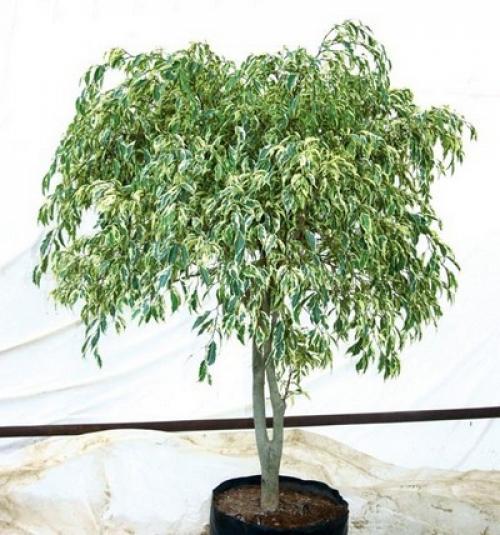

How to water rubber ficus
The next point is about how often to water, and how to determine when it's time. This phycus in spring and summer is in the phase of active growth and, accordingly, at this time, it needs abundant watering when the topsoil dries out. The lack of moisture very quickly affects the state of the plant, after a few days it will begin to lower its leaves and return to its normal appearance only after the situation is corrected, if, of course, it was not critical.
The large glossy leaves of Benjamin Ficus require regular wiping with a damp cloth. This procedure both moisturizes them and removes dust. Spraying from a spray bottle will be helpful.
By the frequency of watering, you need to be guided only by the level of drying out of the soil and choose warm, settled water. The condition of the soil is checked with a wooden stick or just a finger, if the ground does not stick at the level of 2-3 centimeters, it is time to water.
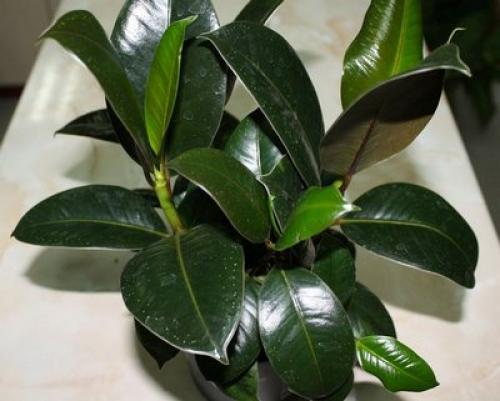

How to water ficus bonsai
Watering the ficus bonsai is not a problem; it just needs to be moderate. The main thing is to prevent the soil from drying out by checking its condition with a wooden stick (given the compact size of the flowerpot, you should not do this with your fingers) and watering it regularly.
When watering, if the bonsai grows in the correct and not too compacted soil, the water will immediately penetrate into the depths.If this does not happen, it is recommended to loosen the soil with sand.
Regular spraying with water at room temperature will have a very good effect on the condition of the plant. It is advisable to carry out such a procedure several times a week, preferably every other day.
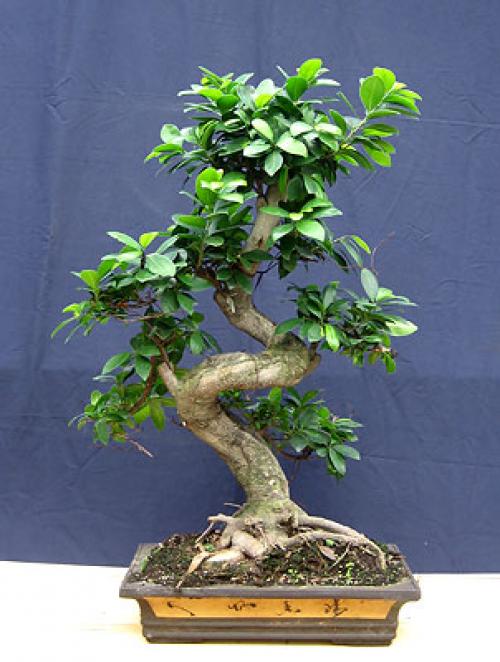

How to water ficus in winter and summer
In conclusion, we note how often to water the ficus in winter and summer, in order to prevent root decay and at the same time dry out the plant, and also to provide the ficus with enough strength for growth.
Different varieties of ficus require a different frequency of watering, since their root system grows and develops in different ways, therefore it is always recommended to check the level of drying out of the soil and only then make a decision on watering. However, if to generalize, then in summer and at the end of spring, when the temperature rises, and the plants enter the phase of active growth, the ficuses are watered no more than twice a week with a moderate amount of water, and in the cold season less often, approximately once every 7-10 days. When spraying ficuses, it is important to remember that, in principle, they do not like drafts and cold air, especially when moisture gets on them. The same is with direct sunlight.
Sumamed instructions for use. special instructions
If one dose of the drug is missed, the missed dose should be taken as early as possible, and the subsequent ones should be taken at intervals of 24 hours.
Sumamed® should be taken at least 1 hour before or 2 hours after taking antacids.
The drug Sumamed® should be used with caution in patients with mild and moderate hepatic impairment due to the possibility of developing fulminant hepatitis and severe hepatic insufficiency. In the presence of symptoms of liver dysfunction, such as rapidly increasing asthenia, jaundice, dark urine, a tendency to bleeding, hepatic encephalopathy, therapy with Sumamed® should be discontinued and a study of the functional state of the liver should be carried out.
In case of impaired renal function in patients with GFR 10-80 ml / min, dose adjustment is not required, therapy with Sumamed® should be carried out with caution under the control of the state of renal function.
As with the use of other antibacterial drugs, during therapy with Sumamed®, patients should be regularly examined for the presence of refractory microorganisms and signs of the development of superinfections, incl. fungal.
The drug Sumamed® should not be used for longer courses than indicated in the instructions, because the pharmacokinetic properties of azithromycin make it possible to recommend a short and simple dosing regimen.
There is no data on the possible interaction between azithromycin and derivatives of ergotamine and dihydroergotamine, but due to the development of ergotism while using macrolides with derivatives of ergotamine and dihydroergotamine, this combination is not recommended.
With prolonged use of Sumamed®, the development of pseudomembranous colitis caused by Clostridium difficile is possible, both in the form of mild diarrhea and severe colitis. With the development of antibiotic-associated diarrhea while taking Sumamed®, as well as 2 months after the end of therapy, clostridial pseudomembranous colitis should be excluded. Do not use drugs that inhibit intestinal motility.
When treating with macrolides, incl. azithromycin, lengthening of cardiac repolarization and QT interval was observed, increasing the risk of developing cardiac arrhythmias, incl. ari.
Caution should be exercised when using Sumamed® in patients with the presence of proarrhythmogenic factors (especially in elderly patients), incl.with congenital or acquired lengthening of the QT interval; in patients taking class IA antiarrhythmics (quinidine, procainamide), III (dofetilide, amiodarone, and sotalol), cisapride, terfenadine, antipsychotics (pimozide), antidepressants (citalopram), fluoroquinolones (moxifloxacin and levofloxacin), in patients with water disorders - electrolyte balance, especially in the case of hypokalemia or hypomagnesemia, clinically significant bradycardia, cardiac arrhythmia or severe heart failure.
The use of Sumamed® can provoke the development of myasthenic syndrome or exacerbate myasthenia gravis.
When used in patients with diabetes mellitus, as well as in patients following a low-calorie diet, it should be borne in mind that sucrose (0.32 XE / 5 ml) is included in the powder for preparing the Sumamed® suspension as an auxiliary substance.
Influence on the ability to drive vehicles and control mechanisms
With the development of undesirable effects on the part of the nervous system and the organ of vision, care should be taken when performing actions that require increased concentration of attention and speed of psychomotor reactions.
Ficus leaves brighten. REASONS OF AN UNPLEASANT PHENOMENON
The yellowing of the leaves of an indoor flower is tantamount to a person's cough during a cold. There may be several reasons for this:
- It should be remembered that the life cycle of ficus leaves is limited. If the plant has been pleasing you with gorgeous, fresh foliage for two to three years, yellowing and subsequent fall of the foliage is considered normal. This happens more often with the lower leaves of the ficus. After the old leaves have faded and fallen, new ones will soon grow in their place. However, if the plant turns yellow completely, you should be alert and look for another reason.
- A change in the living conditions of a culture can cause yellowing and falling of ficus leaves. For a plant, the "move" that has happened is stress, which it reports with yellowness on the leaves. The flower may well suffer due to mistakes made by the owner during transplantation. It may be too small a pot, poor-quality substrate, watering after a culture transplant, etc. Experts do not recommend moving the culture even within the apartment - the ficus is very susceptible to a change in location.
- The most common cause of yellowing and falling leaves in ficus is improper watering. Do not think that abundant watering is only beneficial to the plant. If the soil under the flower is slightly damp, watering should be postponed until the moment when it is completely dry. The moisture content of the soil from the inside can be checked with a long stick.
- Unsuitable room culture conditions can also cause the phenomenon in question. The room in which the ficus is located should be light and warm enough. However, you should not overdo it, the leaves of the ficus are very susceptible to sunlight. In winter, a comfortable temperature for a plant is + 18-20 degrees. It is not recommended to place ficus near batteries - the air there is not only too warm, but also dry.
- Harmful organisms can also lead to yellowing and dropping of ficus leaves. It is necessary to carefully examine the soil and foliage of the plant. If you come across pests, you should immediately purchase a special tool to combat them.
- Lack of nutrients in the soil can cause yellowness on the leaves of the ficus. You can solve the problem by feeding or transplanting a flower, followed by feeding.
Illiterate watering
Sometimes foliage problems also occur due to improper watering of the ficus.
Waterlogging
Typically, yellowing and wilting of leaves occurs due to excessive watering. Although this plant is moisture-loving, its systematic overflow cannot be allowed.Yellowing in the case of excessive watering does not go evenly along the leaf, but in spots, which gradually increase in size.
What to do
Water sparingly: only if the top layer of the substrate dries out. You can check if the soil is dry by sticking a wooden stick into it.
Ficus leaves turn yellow and dry. Improper care
First of all, the leaves of the ficus turn yellow due to the dry air in the house. This condition of detention is most often violated in winter, since the heating system of the room dries up the air very much. The leaves of the flower begin to rapidly change color from green to yellow, after which they dry out and fly around. The rapid fall of the crown has a bad effect on the health of the ficus: having lost its foliage, the flower dies. To avoid this, keep the plant away from the battery and spray the foliage every 2 days.
Direct sunlight is harmful to ficus leaves. With a long stay in the sun, the bush begins to become covered with burns and ulcers, the result of which is yellowing and foliage falling off. A flower growing on a balcony or outside should be planted with shade at noon.
If you often change the location of the tub, the ficus will experience a nervous shock. Stress at the bush is also manifested by yellowing of the foliage. The flower must try to ensure stability, the place must be selected even before the purchase of the culture.
Often the leaves of a ficus turn yellow, the stalk of which has only recently been planted. This is normal for a plant that has not yet taken root in a new pot.
Pay attention to the location of the yellow pigmentation. If the leaf begins to deteriorate at the edges, this indicates too much moisture in the ground. You can not flood the plant: many types of ficuses easily die from root rot.
Lack of nutrients can also cause a yellow crown. If you do not feed the ficus with fertilizer, it will not have internal resources for growth. Feeding the flower should be done regularly. The soil is also selected based on a houseplant. A mixture as a soil for ficus must be made from the following components:
- sand;
- peat;
- leafy land.
Small leaves may turn yellow and fall off the bottom of the trunk. This is a sign of old age and is considered a natural process. However, if the stem of the plant began to rapidly strip, then probably the ficus does not like the pot.
Such a flower should be transplanted into another tub. If the leaves of the plant turn yellow and fall off, the transplant can have a positive effect on the ficus.
Preventive treatment
To avoid yellowed foliage, first of all, you should provide the ficus with maximum care. It should contain a balanced watering regime, a warm and bright room, as well as mineral fertilizing. Often, the home content of different types of flowers may differ from each other.
So, Ficus Benjamin needs more sunlight, but even such a light-loving flower needs to provide shade in the middle of the day. Watering these plants has a certain routine: the soil must have time to completely dry out. Ampel ficus species require an increased amount of moisture in the air and frequent watering. It is recommended to put expanded clay into a pallet of these types and periodically moisten it.
In addition, there are a number of preventive measures to help keep foliage from turning yellow:
- Once a month, the ficus crown should be treated with soapy water. This procedure is especially important for plants that are on an open loggia or growing outdoors.
- After purchasing a flower, quarantine should be observed for some time. This will help to identify diseases in the flower and protect other plants from infection, which can cause yellowing of the leaves.
- Sanitary pruning should be carried out on time, dry foliage should be removed and the tips of the shoots should be equalized.The lower processes should be cut off completely, as they can creep along the ground and take root.
- It is necessary to maintain the distance between the pots, even if the flowers in them are of the same type. If too crowded, the plants begin to wither and lose their foliage.
- Ficus transplant should not happen too often. It is recommended to do this no more than 2 times a year. To renew the soil of an adult plant, experienced florists remove only the top layer of the soil.
- The optimal place for growing the ficus should be chosen in order to limit the number of permutations of the pot.
How to save a ficus leaves fall. What to do if the leaves fall off the ficus?
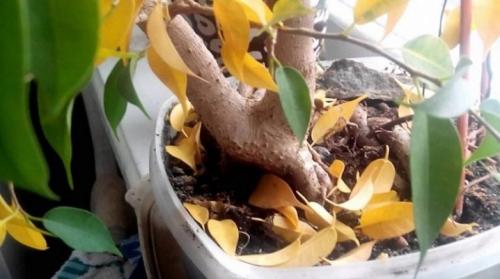

The presence of indoor plants in the room has an extremely positive effect, but in order for green spaces to please with good growth and development, it is important to be able to properly care for them. Florists who grow ficus can face the problem of leaf fall, which is difficult to solve without special knowledge in this area. Determining the reasons, as well as the only correct decisions in each specific situation, will help the plant not only fully recover, but also grow with greater strength.
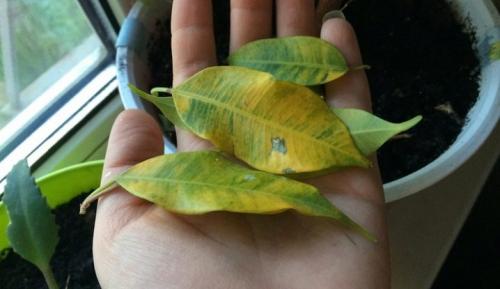

The reasons
If a bought or donated ficus suddenly ceases to please the eye, leaves turn yellow and fly around on it, then you should immediately sound the alarm and find out what is the reason for such a change. There can be quite a few factors for this, so it is so important to determine exactly what happened to the ficus and help it if necessary.
Consider the main reasons why leaves of a ficus can fall off.
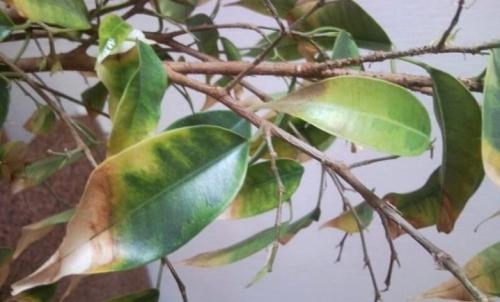

Natural
The plant on its own sheds old foliage, which consumes too many nutrients, and after photosynthesis, practically nothing is released. Such a process is not a problem, because the bush simply rejuvenates itself, makes it possible for young foliage to appear, which will be more beneficial for the ficus and the environment.
These metamorphoses can be observed in autumn, usually towards the end of October. The duration of the change of the leaf cover is from one to two months. During this period, it is worth minimizing the care of the ficus by reducing watering and fertilizing so that the old leaves fall off faster and the bush can replace the old foliage with new one.
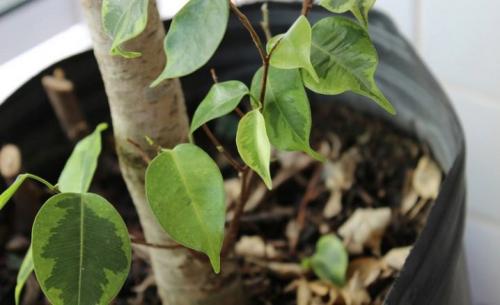

Low temperatures
Inappropriate conditions of detention in the form of cold and humidity - in winter, more frequent discharge of sheets can be noted in those regions where the ambient temperature varies significantly from warm to cold. The threshold temperature at which foliage crumbles in ficus is +14 degrees. This is necessary for the bush in order to preserve vitality before the onset of heat.
To prevent the ficus from freezing, it does not need to be left for the winter in an unheated room, and a sharp decrease in the temperature indicators of the environment should also be avoided.
In terms of moisture, low moisture levels will also help to shed foliage. With unfavorable moisture indicators, the crown turns yellow and dries if it does not receive enough moisture from their soil.
In such extreme conditions, a shortage of nutrients will begin, and the ficus will remain without leaves.
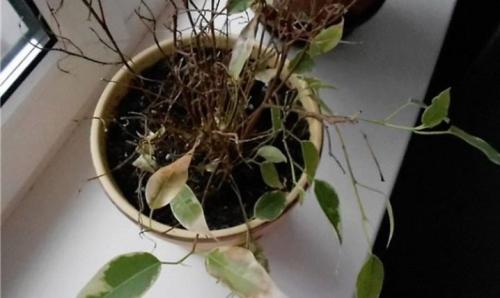

High temperatures
Hot conditions and too warm air for the plant are just as dangerous as cold ones. Leaves fall off in the summer if the temperature exceeds +26 degrees. The plant dries up quickly enough, even if it has good watering and the humidity level remains within normal limits.
A feature of the ficus is the lighting mode, it does not like direct sunlight, but at the same time it cannot exist normally without light.
Only the right place for the pot, optimal temperature and humidity, can prevent the process when the bush throws off the foliage.
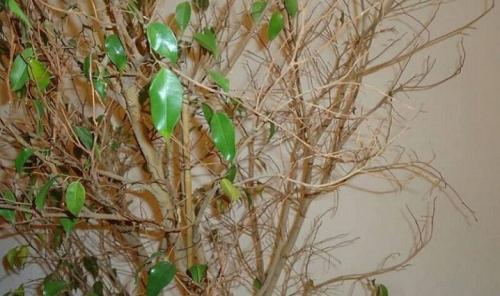

Lack of nutrients
If the conditions of the plant are correct, but the green leaves begin to dry and turn yellow, then the problem is a lack of fertilizers. To save the bush and prevent foliage from falling off, you need to add more nutrients to the soil and carry out such activities regularly.
However, in this case, it is important to be careful not to overdo it with the amount of fertilizer, because an excessive portion of nutrients will lead to overgrowth of the bush, which will cause negative consequences.
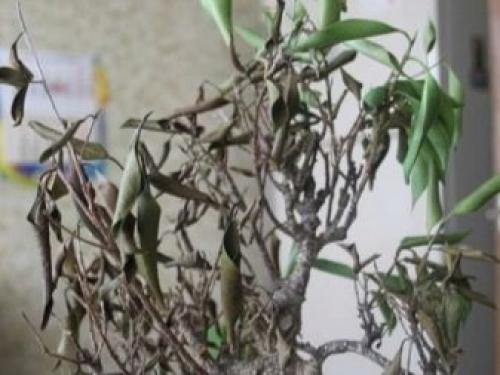

Improper watering
Ficus is a difficult plant to care for due to the difficulty of watering. It is important to give it as much moisture as needed, taking into account the temperature and humidity, since a lack or excess of it will have detrimental consequences.
In moist soil, harmful microorganisms and bacteria begin to actively develop, and the process of rotting of the root system is activated. Root problems are very quickly transmitted to the entire plant, which leads to its complete defeat. If the ficus sharply dropped the leaves, the problem may be precisely in watering, so it is worth assessing the condition of the soil, whether it is too dry or, conversely, swampy.
If the problem is resolved immediately after its detection, the ficus recovery process proceeds without serious complications. However, if the moment is delayed in time, then the branches will also begin to die off, and the bush may lose its attractiveness.
Dry soil also causes problems with the greenery on the plant, since the process of oxygen starvation will be launched, from which the lower leaves, and behind them the rest, turn yellow, curl and fall off.
Prevention measures
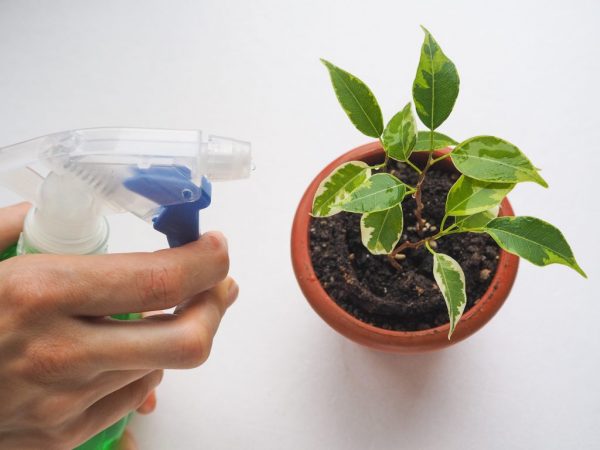

The plant needs careful care. By following all the rules of agricultural technology, you can significantly minimize the risk of problems. Let's take a quick look at useful tips for preventing yellowing and falling foliage in ficus.
- Before buying a flower, decide in advance on its place of stay. Put the pot in this place and do not change it: the ficus is extremely negative about permutations and reacts badly to them.
- It is undesirable to place a plant on the windowsill: the light should not be direct, but diffused.
- Make sure that the room where the ficus is located is warm enough. In addition, it is important to protect the tropical guest from drafts and sudden temperature changes.
- A transplant is necessary, but not more often than once every 2-3 years. Each transplant is very stressful for the plant, so try to carry out them only if absolutely necessary.
- Observe feeding and watering schedules, and regularly inspect the plant for pests or disease symptoms. In the summer, feed the plant once a month; in the winter, it is better to neglect the procedure.
- Care should involve watering the ficus with warm or room temperature water only. The roots of the plant are very sensitive to cold water and can rot with systematic hypothermia.
- Monitor the level of humidity and do not allow it to dry out. If the air is too dry, there is a high probability of the appearance of spider mites and thrips, which are very dangerous pests for the ficus.
- If there is not enough light for the plant in winter, additionally illuminate it with a fluorescent lamp. As for temperature indicators, the following parameters are optimal for ficus: + 20-29 in summer and no less than +16 in winter.
- In winter, water the plant less often: once a week is enough. In general, the cooler it is indoors and outdoors, the more infrequent and less abundant watering should be. Otherwise, you can soon notice that the flower sheds its foliage.
- Loosen the soil between waterings to increase the permeability of the soil.
- Spray ficus regularly, and a warm shower can also be helpful. To remove dust and further moisturize the plant, wipe the fleshy leaves with a damp sponge
- When transplanting due to decay of the root system, it is important to be sure to remove all already decayed roots. There should be no dead tissue left. Sprinkle the slices with charcoal and dry a little: only then transplant.
We learned for what reasons the leaves of the ficus turn yellow, and how to cope with the problems that arise. But before starting treatment, it is necessary to establish the exact cause. Only in this way can you find an effective solution to the problem and restore the health of the ficus in a short time.
Ficus leaves are covered with brown spots. If the leaves shrink and begin to fall
Reasons for the fall of ficus leaves
Several reasons are to blame for this problem:
Your ficus is lacking in nutrients: try changing the soil by replanting the plant. Use leafy soil, peat and sand (in equal proportions). Remember to water your ficus plant immediately after transplanting.
High level of moisture in the soil: this can be understood through the spots appearing on the surface of the leaves, yellowing of the edges and dropping. Wait until the soil is dry and continue with moderate watering. If the ficus continues to fall, then immediately transplant it into new soil and remove the rotten roots.
Remember that the condition of ficus leaves also depends on sparse watering. In this case, they may begin to dry out and wrinkle. If this problem is not solved immediately, the roots may suffer. Then the flower will not be able to live on.
High room temperature, dry air, excess feeding. The leaves are covered with spots and you can get rid of this phenomenon only after removing the causes of the appearance.
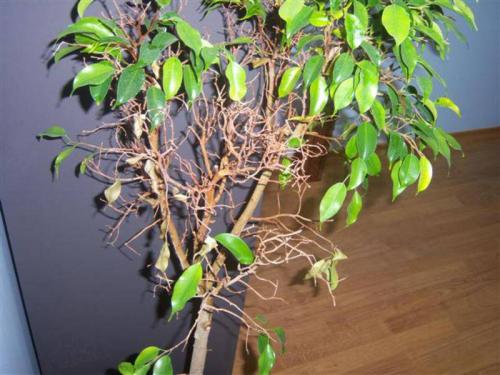

Falling leaves on the bottom of the ficus
If, when the leaves fall below, healthy ones immediately grow, then there is no reason for concern. If new leaves do not appear, then try replanting the plant or choose additional feeding.
Top dressing
The lack of useful components in the soil can cause disruption of the vital systems of the ficus. It is important to remember that in spring this plant is actively growing, therefore, mineral fertilizer should be given a couple of times every two weeks. In winter, the amount of feeding should be reduced, since the plant is dormant. Also, in the period from October to February, it is advisable to reduce the amount of watering. Due to the absence of the summer sun, the plant almost completely stops photosynthesis, so the root system does not actively absorb water. During this period, the ficus sheds excess foliage on its own.
The leaders among useful remedies for the crown of a flower are nitrogen and magnesium. Nitrogen allows ficus to grow new full-fledged leaves faster, and magnesium protects old foliage from aging. In order to compensate for the lack of magnesium in the soil, you can use the following mineral fertilizers:
- magnesium sulfate;
- potassium magnesium;
- dolomite flour.
If the young leaves dry, the ficus most likely lacks iron. In this case, the plant should be fertilized with ferrovite.
The feeding procedure includes a number of preparations. First of all, the flower should be watered a day before fertilization. This precaution will protect the roots of the plant from burns with active mineral components. The fertilization procedure must be carried out according to the instructions. Some types of top dressing should be buried under the top layer of the earth, while others you can simply process the soil from above. There are also special solutions for spraying foliage.
During the disease, the ficus cannot be treated with a full feeding rate. This also applies to the new fertilizer. The dosage of new minerals should be less than half. Care should be taken to ensure that all manipulations bring a positive effect. If, during the treatment, the ficus continues to shed its leaves and quickly turns yellow, the treatment does not give a result.
Ficus caoutchouciferous problems with leaves. All about diseases of the leaves of rubbery ficus
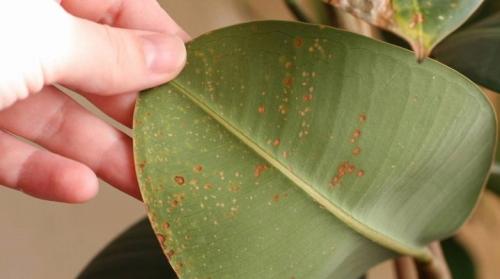

Among all tropical plants that effectively decorate homes, offices and apartments, a special place is occupied by the rubbery ficus - a species that has many obvious advantages. One of them is the unpretentiousness of the ficus, thanks to which it can successfully develop in a variety of conditions, often far from ideal. Despite this advantage, in some cases the leaves can suffer from diseases that pose a serious threat to the health of the plant, and therefore require extremely careful consideration.
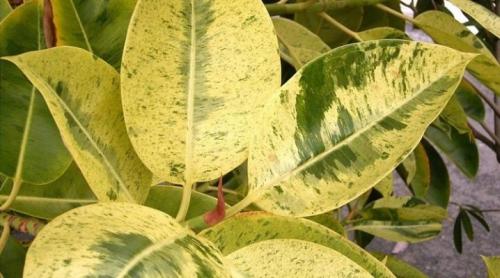

Features of the
The described species, also known as Elastica, is a plant capable of boasting impressive hardiness. One of the confirmations of this thesis is the possibility of placing the ficus in places with relatively low lighting, which does not lead to a negative reaction from the rubber plant. In their natural habitat, representatives of the species in question can reach enormous sizes, exceeding the 30-meter mark. At home, rubbery ficus is not able to achieve such indicators, rarely reaching the height of human growth. As for the leaves, their main features are listed below:
- large sizes (length - up to 30 cm, width - up to 20 cm);
- rich dark green color;
- smooth and shiny surface;
- elongated shape with a pointed top;
- the presence of reddish stipules, acting as "clothing" for young leaves and falling off after they bloom.
Also noteworthy are the varieties of rubber-bearing ficus, the most popular of which are Robusta, Melanie and Abidjan.

